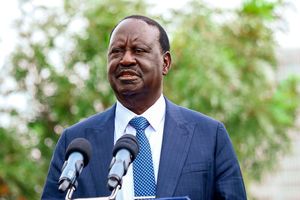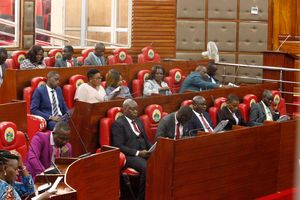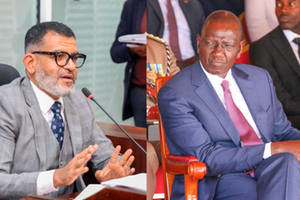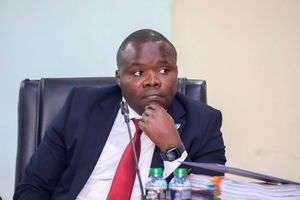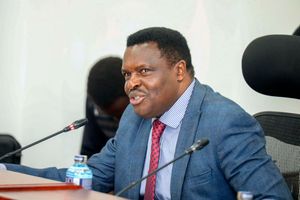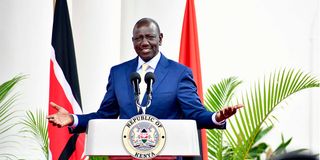
President William Ruto has made good his threats to take over road funds at the heart of a fierce battle between counties and Members of Parliament.
President William Ruto has made good his threats to take over road funds at the heart of a fierce battle between counties and Members of Parliament by opening a new spending line dubbed “road works” in the national government’s upcoming budget.
Budget estimates for the financial year starting July tabled in the National Assembly by the Treasury introduce a new vote, or allocation, of Sh11.47 billion under the State Department for Roads with a big chunk of the funds going towards the construction of feeder and rural access roads, the source of jostling between counties and law-makers.
In what is likely to open a new battlefront, the national government has taken over projects that county governments had already started constructing, as the fight between county chiefs and MPs over the control of Sh10 billion kitty drawn from the Road Maintenance Levy Fund (RMLF) rages on.
It is a major statement of intent for the Ruto administration, which, unlike the previous government, is yet to launch a major road project. The Ruto-led administration is hobbled by the country’s high risk to debt distress, which makes it difficult for it to take up loans to build big-ticket infrastructure projects like his predecessor.
The new vote, dubbed ‘road works,’ will also see some of the funds channelled to road clusters, mostly in constituencies in Luo Nyanza, the backyard of former Prime Minister Raila Odinga who threw his weight behind a beleaguered President Ruto at the height of the anti-tax protests in June last year.
With two years to the 2027 elections, Dr Ruto will be keen to inherit all the Luo Nyanza votes from Mr Odinga, assuming that the latter’s ODM Party does not field a presidential candidate and instead supports the president for a second term.
This explains why some of the clusters that will benefit from funds are mostly in Luo Nyanza, including Suba South, Nyatike and Ndhiwa constituencies, each of which has been allocated Sh100 million.
The other two clusters are Kieni Constituency and Mandera County, which have also been allocated Sh100 million each.
Also in Nyanza, Dr Ruto’s government will also take over the upgrading of Tella–Gogo Road bitumen standards. The project in Migori County, which includes grading, gravelling, and tarmacking to improve durability and reduce maintenance costs, has been allocated Sh100 million.
The project had primarily been funded by the Migori County’s Roads, Transport, and Public Works Department.
Migori County had also contributed to the maintenance of Kanyawanga–Dede–Rapogi Road, injecting around Sh9.7 million to the project in the last fiscal year. But in the upcoming fiscal year, the national government has allocated Sh300 million for the road to be tarmacked.
The tender to grade and gravel the road had primarily been funded and managed under the 10 percent RMLF by the Kenya Rural Roads Authority (KeRRA).
In Siaya County, the Wangarot–Asembo Bay–Kalendiu Road, a crucial link between various communities, which had initially been funded by KeRRA, has been awarded Sh100 million.
Still in Siaya County, the Treasury has allocated Sh200 million for the upgrading of Sidindi–Sigomere–Masiro Road to facilitate access to markets, schools, and healthcare facilities.
The project was to be primarily funded by the Siaya County Government through the Department of Public Works, Roads, Energy, and Transport, which floated the tender in the current financial year. However, financing of the project has since been included in the national government’s budget.
Amid the fighting, President Ruto has made it clear that he would like to get hold of the kitty, dismissing both the counties and lawmakers for doing shoddy work with the funds they have received from RMLF.
“I am aware there is an ongoing tussle between county governments and Parliament, especially over the road maintenance funds,” said President Ruto during the Easter Sunday service in Ntulele, Narok County.
“If you leave the funds to me, I will organise to fund all these road projects. Because with that money, you end up building a small murram road from here to there, and after one day of rain, it is all washed away.”
Counties and lawmakers are locked in a court battle over the control of around Sh10 billion that comes from the RMLF.
Mr Odinga has waded into the fight, calling for the dissolution of KeRRA and Kura, and leaving the road projects to the counties.
Under the Fourth Schedule of the Constitution, county governments are in charge of “county roads” and the national government “the construction and operation of national trunk roads”.
However, due to the lack of a proper definition of the different roads, it is not clear which roads should be the responsibility of the counties and which should be the responsibility of the national government.
Retired President Uhuru Kenyatta’s Jubilee administration had noted in its manifesto before it came to power in 2013 that it would abolish KeRRA and the Kenya Urban Roads Authority (Kura) and hand over the construction of “secondary and minor roads” to county governments.
However, the Kenyatta government never made good on this promise. MPs were particularly opposed, as KeRRA works directly with the Constituency Roads Committee.
MPs and county governments fear that without influence over roads in their areas, they are unlikely to be able to deliver on their election promises.
Counties have also seen road construction, more than any other devolved function, as the only way to show voters that they are working.
The allocation to the Kenya Roads Board (KRB), which allocates the funds from the RMLF to various road agencies and ultimately to counties and constituencies, is estimated at Sh32 billion for the financial year starting in June.
The KRB allocates the money to various road agencies for maintenance, rehabilitation and development of roads.
These road agencies include the Kenya National Highways Authority (KeNHA), which maintains and develops international and national trunk roads; Kura which maintains urban roads in cities and municipalities; and KeRRA, which handles rural and low-volume roads.
Other recipients of the Kenya Roads Board funds include the Kenya Wildlife Service, which maintains roads in national parks and reserves. The Ministry of Roads may receive funds for special projects or policy-related initiatives.
Following devolution under the 2010 Constitution, the maintenance of Class D and below roads, which include minor roads within counties, became the responsibility of devolved governments.
The Kenya Roads Board channels a significant portion of the RMLF to KeRRA, which then implements or coordinates rural road maintenance in consultation with county governments.

